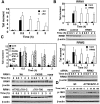Essential role of Tip60-dependent recruitment of ribonucleotide reductase at DNA damage sites in DNA repair during G1 phase
- PMID: 20159953
- PMCID: PMC2816732
- DOI: 10.1101/gad.1863810
Essential role of Tip60-dependent recruitment of ribonucleotide reductase at DNA damage sites in DNA repair during G1 phase
Abstract
A balanced deoxyribonucleotide (dNTP) supply is essential for DNA repair. Here, we found that ribonucleotide reductase (RNR) subunits RRM1 and RRM2 accumulated very rapidly at damage sites. RRM1 bound physically to Tip60. Chromatin immunoprecipitation analyses of cells with an I-SceI cassette revealed that RRM1 bound to a damage site in a Tip60-dependent manner. Active RRM1 mutants lacking Tip60 binding failed to rescue an impaired DNA repair in RRM1-depleted G1-phase cells. Inhibition of RNR recruitment by an RRM1 C-terminal fragment sensitized cells to DNA damage. We propose that Tip60-dependent recruitment of RNR plays an essential role in dNTP supply for DNA repair.
Figures




Similar articles
-
The direct interaction of NME3 with Tip60 in DNA repair.Biochem J. 2016 May 1;473(9):1237-45. doi: 10.1042/BCJ20160122. Epub 2016 Mar 4. Biochem J. 2016. PMID: 26945015
-
Thymidylate kinase is critical for DNA repair via ATM-dependent Tip60 complex formation.FASEB J. 2019 Feb;33(2):2017-2025. doi: 10.1096/fj.201800856R. Epub 2018 Sep 10. FASEB J. 2019. PMID: 30199284
-
Fe65 is required for Tip60-directed histone H4 acetylation at DNA strand breaks.Proc Natl Acad Sci U S A. 2009 Mar 31;106(13):5093-8. doi: 10.1073/pnas.0810869106. Epub 2009 Mar 12. Proc Natl Acad Sci U S A. 2009. PMID: 19282473 Free PMC article.
-
Mechanisms of dNTP supply that play an essential role in maintaining genome integrity in eukaryotic cells.Cancer Sci. 2010 Dec;101(12):2505-9. doi: 10.1111/j.1349-7006.2010.01719.x. Epub 2010 Sep 28. Cancer Sci. 2010. PMID: 20874841 Free PMC article. Review.
-
Tip60 in DNA damage response and growth control: many tricks in one HAT.Trends Cell Biol. 2006 Sep;16(9):433-42. doi: 10.1016/j.tcb.2006.07.007. Epub 2006 Aug 9. Trends Cell Biol. 2006. PMID: 16904321 Review.
Cited by
-
Polymerases in nonhomologous end joining: building a bridge over broken chromosomes.Antioxid Redox Signal. 2011 Jun 15;14(12):2509-19. doi: 10.1089/ars.2010.3429. Epub 2010 Oct 28. Antioxid Redox Signal. 2011. PMID: 20649463 Free PMC article. Review.
-
Enhanced sensitivity to cisplatin and gemcitabine in Brca1-deficient murine mammary epithelial cells.BMC Pharmacol. 2011 Jul 19;11:7. doi: 10.1186/1471-2210-11-7. BMC Pharmacol. 2011. PMID: 21771338 Free PMC article.
-
Physical interactions between specifically regulated subpopulations of the MCM and RNR complexes prevent genetic instability.PLoS Genet. 2024 May 22;20(5):e1011148. doi: 10.1371/journal.pgen.1011148. eCollection 2024 May. PLoS Genet. 2024. PMID: 38776358 Free PMC article.
-
Targeting PFKFB3 radiosensitizes cancer cells and suppresses homologous recombination.Nat Commun. 2018 Sep 24;9(1):3872. doi: 10.1038/s41467-018-06287-x. Nat Commun. 2018. PMID: 30250201 Free PMC article.
-
Prognostic and Immunological Potential of Ribonucleotide Reductase Subunits in Liver Cancer.Oxid Med Cell Longev. 2023 Jan 20;2023:3878796. doi: 10.1155/2023/3878796. eCollection 2023. Oxid Med Cell Longev. 2023. PMID: 36713030 Free PMC article.
References
-
- Dong Q, Wang TS. Mutational studies of human DNA polymerase α. Lysine 950 in the third most conserved region of α-like DNA polymerases is involved in binding the deoxynucleoside triphosphate. J Biol Chem. 1995;270:21563–21570. - PubMed
-
- Fukushima M, Fujioka A, Uchida J, Nakagawa F, Takechi T. Thymidylate synthase (TS) and ribonucleotide reductase (RNR) may be involved in acquired resistance to 5-fluorouracil (5-FU) in human cancer xenografts in vivo. Eur J Cancer. 2001;37:1681–1687. - PubMed
-
- Guittet O, Hakansson P, Voevodskaya N, Fridd S, Graslund A, Arakawa H, Nakamura Y, Thelander L. Mammalian p53R2 protein forms an active ribonucleotide reductase in vitro with the R1 protein, which is expressed both in resting cells in response to DNA damage and in proliferating cells. J Biol Chem. 2001;276:40647–40651. - PubMed
-
- Hakansson P, Hofer A, Thelander L. Regulation of mammalian ribonucleotide reduction and dNTP pools after DNA damage and in resting cells. J Biol Chem. 2006;281:7834–7841. - PubMed
Publication types
MeSH terms
Substances
LinkOut - more resources
Full Text Sources
Other Literature Sources
Miscellaneous
